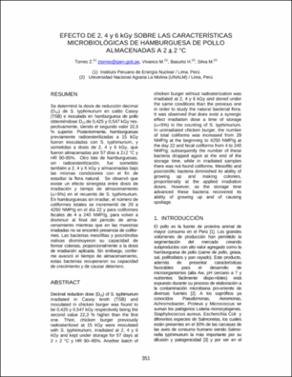Efecto de 2, 4 y 6 kGy sobre las características microbiológicas de hamburguesa de pollo almacenadas a 2 ± 2 °C
Fecha
2002-06Metadatos
Mostrar el registro completo del ítemResumen / Abstract
Se determinó la dosis de reducción decimal (D10) de S. typhimurium en caldo Casoy (TSB) e inoculada en hamburguesa de pollo obteniéndose D10 de 0,425 y 0,547 kGy respectivamente, siendo el segundo valor 22,3 % superior. Posteriormente, hamburguesas previamente radioesterilizadas a 15 kGy fueron inoculadas con S. typhimurium y sometidas a dosis de 2, 4 y 6 kGy, que fueron almacenadas por 57 días a 22 °C y HR 90-95%. Otro lote de hamburguesas, sin radioesterilización, fue sometido también a 2, 4 y 6 kGy y almacenadas bajo las mismas condiciones con el fin de estudiar la flora natural. Se observó que existe un efecto sinergista entre dosis de irradiación y tiempo de almacenamiento (α=5%) en el recuento de S. typhimurium. En hamburguesas sin irradiar, el número de coliformes totales se incrementó de 29 a 4250 NMP/g en el día 22 y para coliformes fecales de 4 a 240 NMP/g, para volver a disminuir al final del periodo de almacenamiento mientras que en las muestras irradiadas no se encontró presencia de coliformes. Las bacterias mesófilas y psicrótrofas nativas disminuyeron su capacidad de formar colonias, proporcionalmente a la dosis de irradiación aplicada. Sin embargo, conforme avanzó el tiempo de almacenamiento, estas bacterias recuperaron su capacidad de crecimiento y de causar deterioro.
Decimal reduction dose (D10) of S. typhimurium irradiated in Casoy broth (TSB) and inoculated in chicken burger was found to be 0,425 and 0,547 kGy respectively being the second value 22,3 % higher than the first one. Then, chicken burger previously radiosterilized at 15 kGy was inoculated with S. typhimurium, irradiated at 2, 4 and 6 kGy and kept under storage for 57 days at 2± 2 oC and HR 90 5%. Another batch of chicken burger without radiosterilization was irradiated at 2, 4 and 6 kGy and stored under the same conditions than the previous one in order to study the natural bacterial flora. It was observed that there is a synergic effect between irradiation dose and time of storage (α=5%) in the counting of S. typhimurium. In unirradiated chicken burger, the number of total coliforms increased from 29 NMP/g at the beginning to 4250 NMP/g at day 22 and fecal coliforms from 4 to 240 NMP/g; subsequently the number of these bacteria dropped again at the end of the storage time, while in irradiated samples no coliforms were found. Mesophilic and psychrotrophic bacteria diminished its ability of growing up and making colonies, proportionally to the applied irradiation doses. However, as the storage time advanced these bacteria recovered its ability to grow up and of cause spoilage.
Editorial
Lima





